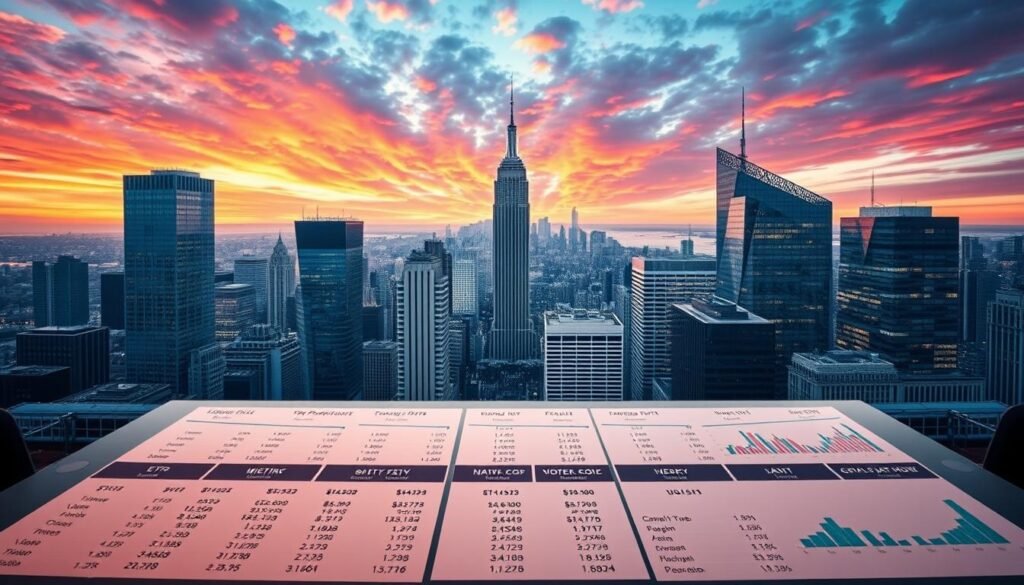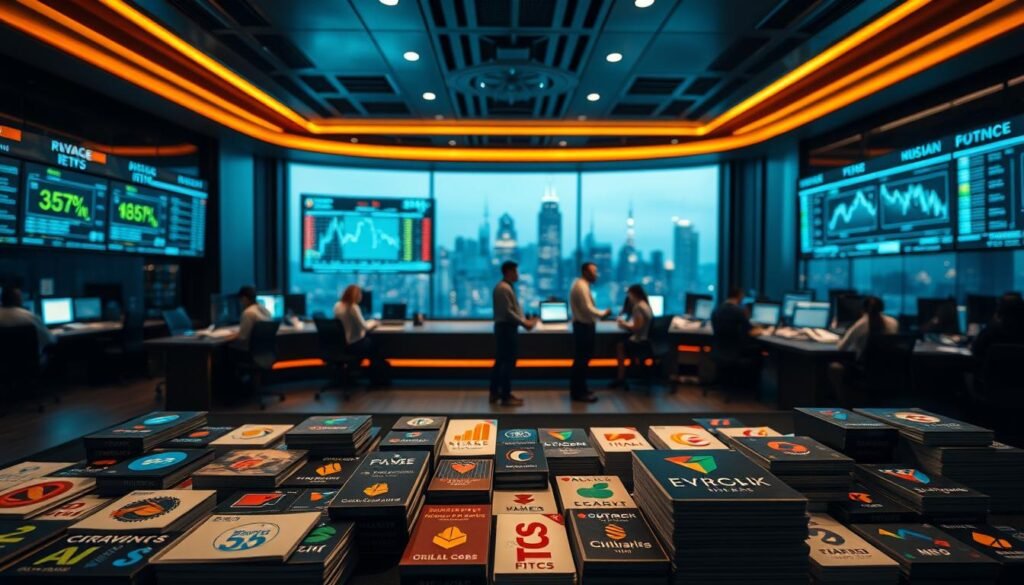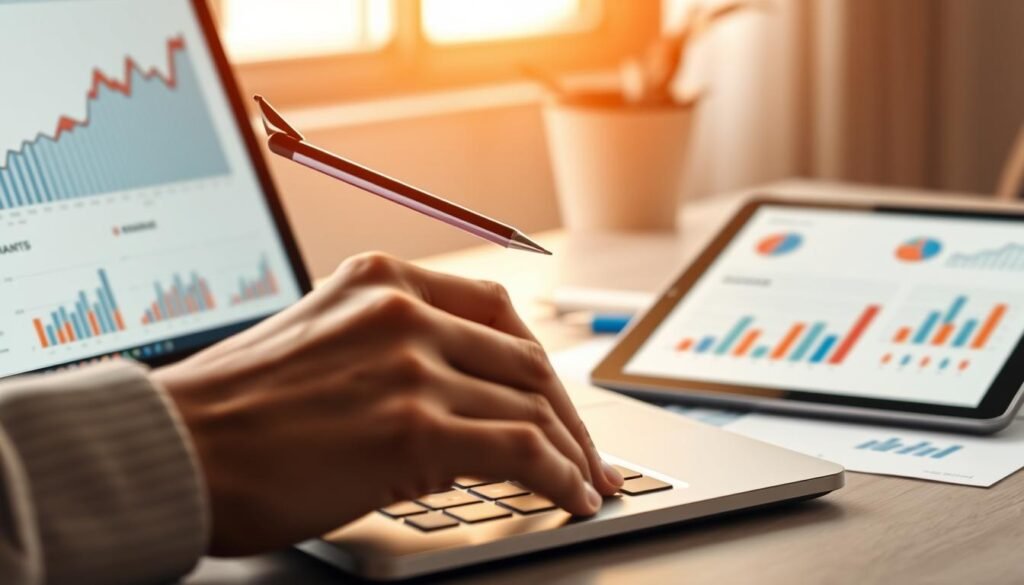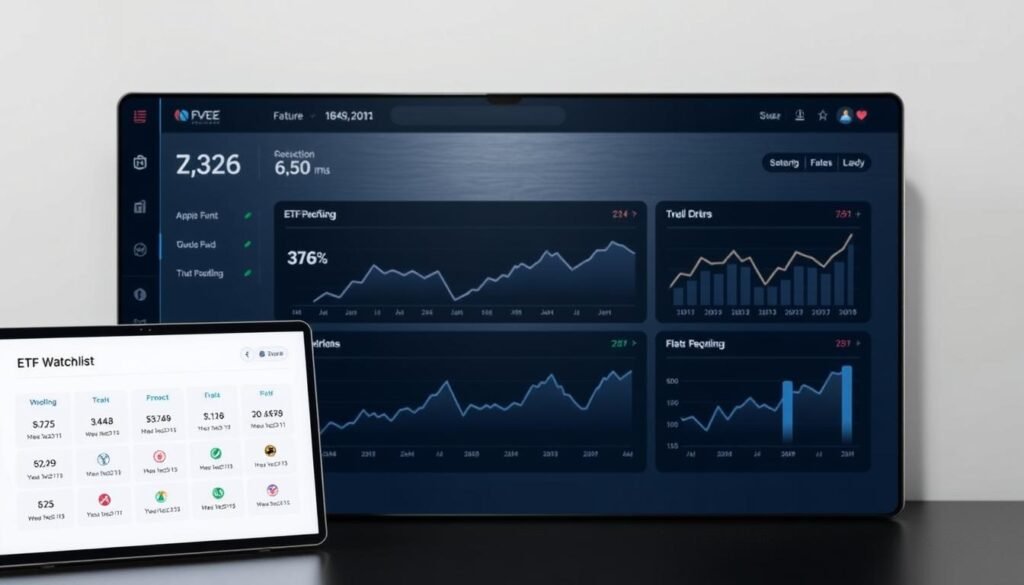
Guide to Top Performing ETFs USA 2026 List

You’re about to get a clear, practical intro to exchange-traded funds and how they can fit into your portfolio. Think of the time you bought a single company stock after a hot tip and felt nervous watching intraday swings. That feeling is common.
Now imagine buying a fund that trades like a stock all day but gives instant diversification. ETFs often cost less and are tax-efficient, so they can simplify long-term investment work for you.
In August 2025, market leaders such as YieldMax Gold Miners Option Income Strategy ETF (GDXY) and Invesco S&P SmallCap 600 Pure Value ETF (RZV) showed how niche themes can fuel short-term gains. This guide will give you a concise list and the information you need to judge price, liquidity, fees, and ratio impacts.
By the end, you’ll know how to compare funds with individual stocks and map these ideas into your accounts when you rebalance or build new positions.
- Why “top performing ETFs USA” matters for your 2026 portfolio
- Methodology: How you evaluate the best performers for 2026
- The 2026 short list: Top performing ETFs USA to watch
- Standout 2025 performers informing the 2026 view
- What the numbers say: Expense ratios, AUM, categories, and ratings
- Deeper dives: Strategy, holdings, and role in your portfolio
- Large-cap tilt example: iShares Top 20 U.S. Stocks ETF (TOPT)
- How to buy ETFs the smart way
- Risk, taxes, and time horizon: What you should weigh
- Performance data changes fast: Use current sources and prospectuses
- Your next step: Build a 2026-ready ETF list that fits your goals
Why “top performing ETFs USA” matters for your 2026 portfolio
Watching recent fund leaders helps you spot the factor angles that could shape returns next year. That matters because short-term wins often reveal a value or miners tilt that may persist into the next year.
Performance now, positioning for the next year
Use recent performance as a signal, not a script. You can learn which sectors and factor styles led the market, then decide how much to add to your portfolio for 2026.
Day-traded access, tax efficiency, and costs
Exchange-traded funds trade throughout the day, so you can watch price action and use limit orders like you would with stocks.
They also offer higher tax efficiency than many mutual funds. That can help you keep more of your returns over multi-year investments.

- You can spot factor tilts (value, miners) and set allocations for the coming year.
- All-day trading gives control over entry and exit timing and spreads.
- Fees matter: use the 0.15% average expense ratio for equity index ETFs as a screening reference.
- Balance short-term signals with a long-term plan so one month’s gains don’t steer your whole strategy.
Methodology: How you evaluate the best performers for 2026
Clear rules make comparison simple. You want a data-driven screen that focuses on Morningstar U.S.-listed equity products and avoids structural oddities. That keeps your shortlist grounded in tradable, well-documented options.

Screening and minimum requirements
Exclude ETNs and funds with less than $100 million in assets. This reduces the chance of thin liquidity or unusual risk. You’ll keep only funds that show consistent history and measurable assets.
Balancing long-term returns and recent momentum
Prioritize multi-year performance across cycles while noting short-term momentum for the latest period. This helps you see whether a fund’s current gains reflect durable strategy or a brief surge.
Set an expense ratio ceiling to limit fee drag. Check average volume, bid/ask spreads, and market depth so trades execute cleanly.
- Separate active vs. passive types and document the investment strategy.
- Tag factor exposure value, momentum, size, quality so you avoid overlap.
- Prefer etfs based on transparent index rules when you want predictable, rules-based exposure.
| Check | Minimum | Why it matters | Data point |
|---|---|---|---|
| Listing | U.S.-listed equity | Regulatory and trading standards | Morningstar category |
| Assets | > $100M | Reduces liquidity risk | AUM |
| Fees | Expense ratio ceiling | Limits long-term drag | Expense ratio |
| Liquidity | Healthy volume & spread | Efficient order execution | Avg volume / spread |
The 2026 short list: Top performing ETFs USA to watch
Consider this curated list of six funds that blend income, value, and momentum approaches you can review before 2026.
YieldMax Gold Miners Option Income Strategy ETF (GDXY)
GDXY uses options to generate income on miner exposure. It launched in May 2024 and posted a 13.47% gain in August with a 32.83% one-year return. Note its Neutral Morningstar medalist rating and large-blend category.
Invesco S&P SmallCap 600 Pure Value (RZV)
RZV offers a pure small-cap value tilt and traces back to 2006. Expect a 0.35% expense ratio, two-star Morningstar rating, and steady value-oriented holdings to study across market cycles.
EA Bridgeway Omni Small-Cap Value (BSVO)
BSVO is an actively managed small-value fund with a Silver Medalist rating and a 0.47% fee. Its process aims to differentiate within the small-value sleeve.

| Ticker | Category | Aug 2025 | 1-Year | Expense |
|---|---|---|---|---|
| GDXY | Large-blend (miners) | 13.47% | 32.83% | — |
| RZV | Small Value | 11.64% | 11.05% | 0.35% |
| BSVO | Small Value (active) | 10.68% | 4.63% | 0.47% |
| XMVM | Mid/Value + Momentum | 8.91% | 11.52% | 0.39% |
| MGMT | Small/Mid Blend (active) | 8.70% | 16.88% | 1.10% |
| AVSC | Small Value (systematic) | 8.64% | 5.99% | 0.25% |
- You can start your watchlist with GDXY for options-derived income on gold miners exposure and its recent strength.
- Add RZV for deep small-cap value purity and a long track record to test across cycles.
- Include BSVO as an actively managed small-value option with a Silver medalist rating.
- Consider XMVM for a rules-based value-plus-momentum strategy and strong one-year returns.
Watch for holdings overlap among small-value names and compare top positions so you avoid doubling exposure. Use these choices as a starting point and size allocations to fit your risk and plan.
Standout 2025 performers informing the 2026 view
Late-summer data for the year showed a clear tilt toward small-value exposure, and you can use that signal when shaping your 2026 plan.
The August 2025 period produced meaningful gains: seven funds in the small-value category outperformed, with the average name up 7.10%.
Small-value category strength and August 2025 leaders
RZV, BSVO, XMVM, MGMT, and AVSC rose together, which suggests broad participation across the style box rather than a single-stock move.
Metals-related themes were prominent. GDXY and several gold and silver miners funds led the rally, showing how commodity strength can lift sector-focused etf exposure.
- You can treat August performance as timely data but not a certainty for 2026.
- Watch whether leadership broadens beyond small-value stocks or stays clustered.
- Note that actively managed fund choices like BSVO and MGMT may differentiate in shifting conditions.
What the numbers say: Expense ratios, AUM, categories, and ratings
Numbers give you a clear filter. Start with cost and rating signals to decide which small-value and small-blend equity choices deserve a place in your portfolios.
Costs snapshot
Expense ratio levels vary across similar strategies. RZV is 0.35%, SVAL is 0.20%, XMVM is 0.39%, FYT is 0.72%, and MGMT is 1.10%.
Use these figures to estimate fee drag on potential returns when you model allocation sizes.
Medalist and star ratings context
Star ratings are backward-looking. Medalist ratings reflect analysts’ forward view.
"Combine both ratings to see past performance and forward conviction."
| Ticker | Expense | Rating | Category |
|---|---|---|---|
| RZV | 0.35% | 2-star / Neutral | Small value |
| SVAL | 0.20% | 2-star / Gold | Small blend |
| XMVM | 0.39% | 5-star / Silver | Value/momentum |
- Verify assets and trading data so the etf you pick has depth for efficient trades.
- Remember lower fees raise the odds you keep more gross returns, but they do not guarantee success.
- Check prospectuses for any esg disclosures and align the fund with your risk and allocation plan.
Deeper dives: Strategy, holdings, and role in your portfolio
Dig into how each fund is built so you can assign a clear role in your plan.
GDXY: Actively managed option income and miner sensitivity
GDXY is an actively managed sleeve that uses options to generate income over gold miners exposure. It launched in May 2024, carries a Neutral medalist view, and posted 13.47% in August with 32.83% one-year returns.
RZV and SVAL: Pure value vs. factor-driven small-cap value
RZV follows a pure value construction with a 0.35% expense ratio and classic stock-level value screens. SVAL uses a multi-metric factor approach, a 0.20% fee, and a Gold medalist rating—choose purity or a composite value tilt.
XMVM: Blending factor exposures for potential excess returns
XMVM blends value and momentum rules and carries five-star, Silver medalist signals. Its rules-based strategy can smooth returns when regimes favor factor mixes.
MGMT and AVSC: Active vs. systematic small-cap approaches
MGMT relies on active security selection across small/mid equity and has a 1.10% fee with 16.88% one-year. AVSC is systematic, cheaper at 0.25%, and aims for stable small-cap exposure.
| Ticker | Expense | 1-Yr |
|---|---|---|
| GDXY | — | 32.83% |
| RZV | 0.35% | 11.05% |
| XMVM | 0.39% | 11.52% |
| MGMT | 1.10% | 16.88% |
- Check holdings overlap to avoid doubling exposure to the same stocks or sectors.
- Match each investment strategy to your time horizon and size as a core or tactical sleeve.
- Monitor ratings and performance attribution to confirm the fund delivers as intended.
A concentrated large-cap sleeve can sharpen your portfolio when mega-cap leaders drive returns.
What you get: TOPT offers exposure to the S&P 500 Top 20 Select Index via an iShares product. The fund charges a 0.20% expense ratio and pays quarterly distributions, making it a low-cost way to own dominant companies.
Key stats and context: TOPT trades on NYSE Arca. As of Sep 26, 2025, net assets were about $334,255,647 and the closing price was 30.18.
| Metric | Value | Notes |
|---|---|---|
| Listing | NYSE Arca | Liquid U.S. venue |
| Number holdings | 21 | Concentrated exposure to major companies |
| P/E / P/B | 35.82 / 9.39 | Premium valuation for mega-cap growth |
| Net assets | $334,255,647 | Size supports efficient trading |
You’ll note the 30-day median bid/ask spread is 0.03% and the 30-day SEC yield was 0.43% as of Aug 31, 2025. Use the number shares and allocation sizing to limit overlap with your small-value sleeves.
Actionable tip: Treat TOPT as a core large-cap complement or a tactical overlay. Review the prospectus for index rebalancing rules so you can anticipate turnover events that shift the fund’s equity profile.
How to buy ETFs the smart way
Start by deciding whether you want hands-on control or an automated portfolio manager. That choice guides every step, from screening to trade execution.
Open a brokerage or choose a robo-advisor
You’ll decide between a full-service brokerage for self-directed trades or a robo-advisor for automated portfolios. Many brokers offer commission-free trades, while robo services pick and rebalance etfs for you.
Use screeners: Expense ratio, performance, volume, and holdings
Use your broker’s screener to filter on expense ratio (the industry average is ~0.15% for equity index funds), multi-year performance, trading volume, and top holdings.
Place the trade: Tickers, order types, and bid/ask spreads
Enter the ETF ticker, then choose an order type that matches your risk and price goal. Check the bid/ask spread to estimate implicit cost.
| Order type | When to use it |
|---|---|
| Market | Fast execution during high liquidity |
| Limit | Control the price you pay |
| Stop / Stop-limit | Manage downside or trigger exits |
Monitor periodically and rebalance by plan
You’ll calculate the number shares to buy based on allocation and cash. Document each fund’s role before you buy so monitoring and rebalancing stay intentional.
- Compare an etf to individual stocks if you want instant diversification with one trade.
- Keep records of order confirmations, distributions, and taxes for organized investments.
"Treat discipline screening, order choice, and periodic rebalancing as the core edge for long-term success."
For a practical starting checklist, see this ETF guide to refine your process and choices.
Risk, taxes, and time horizon: What you should weigh
Assessing risk, tax timing, and your investment horizon will shape how you size and hold volatile sleeves. That mindset helps you avoid reactionary moves when markets swing.
Volatility in small-value and thematic miners
Small-value and miner exposures can jump and drop quickly. You’ll size these allocations smaller if you want to limit short-term drawdowns.
Market phases rotate, so factor leadership may reverse. Diversify by style and sector to reduce single-theme risk.
Tax efficiency of ETFs and distribution timing
ETFs generally give higher tax efficiency versus open-end mutual funds, but distributions still occur. You’ll plan around dividend and capital gains dates.
Use taxable accounts wisely: hold tax-efficient sleeves there and reserve core holdings for long-term growth to manage after-tax returns.
- Size small-value and miners carefully to manage volatility and potential sharp drawdowns.
- Remember that past returns don’t guarantee future results; rotate exposures when your plan calls for it.
- Confirm fund structure and holdings for concentration, liquidity, or derivatives risks.
- Keep life events and cash needs in mind so you aren’t forced to sell during down periods.
- Use tax-loss harvesting and review distribution schedules to improve net returns.
"Align each fund with your time horizon so you can hold through routine volatility and pursue the returns the strategy targets."
Performance data changes fast: Use current sources and prospectuses
Numbers move quickly in the market, so verify facts before you act. Rely on sponsor pages and the latest prospectus for official performance and fee disclosures. Standardized performance and month-end snapshots are the authoritative sources for any fund you consider.
Past performance is illustrative, not predictive. Investment returns and principal fluctuate. Use like-for-like periods when you compare one fund to another.
Past performance caveats and accessing standardized performance
Check NAV procedures and how bid/ask prices may differ from valuation times during the trading day. iShares and other sponsors note that price, holdings, and valuation methods can vary.
| What to verify | Where to find it | Why it matters |
|---|---|---|
| Standardized performance | Fund performance section / prospectus | Ensures apples-to-apples period comparisons |
| Fees and ratios | Fee table in prospectus | Impacts long-term returns |
| NAV valuation | Sponsor disclosures / daily NAV notice | Explains price differences during market hours |
| Holdings and sector tags | Monthly holdings report | Confirms exposure to themes like gold miners |
- Verify numbers with the fund sponsor rather than relying solely on third-party summaries.
- Double-check rating updates and methodology notes before you rely on a star or medalist view.
- Compare year-over-year figures to identify if a fund’s performance is consistent or skewed by a single period.
- Read the prospectus to confirm objectives, risks, fees, and valuation policies for any exchange-traded funds you’re evaluating.
"Performance quotes represent past performance and do not guarantee future results; investment returns and principal fluctuate."
Your next step: Build a 2026-ready ETF list that fits your goals
Begin assembling your 2026 list by mapping each fund to a clear portfolio role. Decide whether you prefer a brokerage or a robo for execution. Screen for cost, volume, holdings, and standardized performance before buying.
Place trades by ticker with the order type that matches your goal. Size shares to match risk limits and use limit orders to control price. Track distributions and rebalance on a calendar so your portfolios stay aligned.
Keep fees low where possible, accept higher-cost funds only for a clear edge, and verify prospectuses. These steps let you use ETF tools to pursue long-term investment aims without reacting to every market move.
If you want to know other articles similar to Guide to Top Performing ETFs USA 2026 List you can visit the category Scholarships.






Leave a Reply